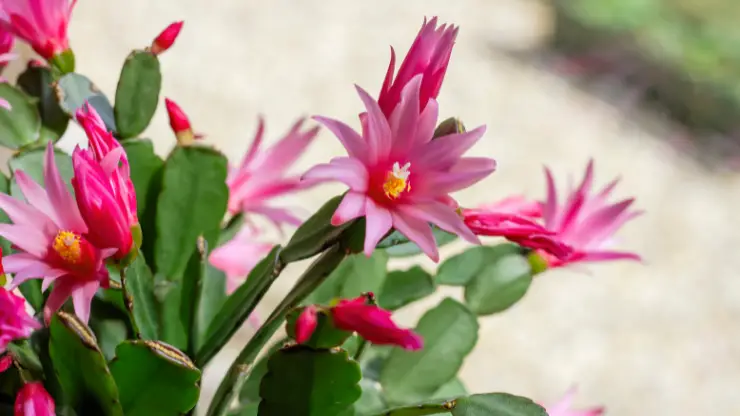
Easter cactus (Hatiora gaertneri) is a popular flowering houseplant that blooms in late spring. It’s easy to grow indoors for the most part, but does require a period of rest after flowering. With proper care, it can live up to six years in typical household conditions.
Why is my Easter cactus dying? Too little or too much water, too much sunlight, low humidity, and incorrect temperatures are the most common reasons that an Easter cactus declines. This plant needs moist (but not wet) soil, bright indirect sunlight, and high humidity to thrive. Plus, it needs proper care after flowering to ensure blooms the next year.
In this post, we’ll offer some easy solutions to all these common problems so you can make your Easter cactus happy and healthy for years to come.
Not Enough Water
Underwatering is probably the biggest problem with Easter cactus. As a rain forest native, this plant needs lots of water – more than most other types of cacti. If you notice your Easter cactus leaves wrinkling, that’s a good sign that it’s not receiving enough water.
For the best results, adjust watering based on the season. Follow these guidelines:
- SPRING: Allow the soil to dry out for an entire month after blossoms fade. This usually happens in late spring to early summer. Before flowers fade, follow winter watering instructions.
- SUMMER – FALL: After the month of dry rest, water thoroughly and keep the soil slightly moist at all times. Never let it become soggy or wet, but water when you the top of the soil feels dry to the touch.
- WINTER: Water only when the potting medium dries out to a depth of 1 inch (2.5 cm). Test soil moisture by inserting your finger into the soil up to the first knuckle. If the soil feels dry, it’s time to water. If it feels moist, check again tomorrow.
Unsure if your plant is underwatered? See my post on How to Tell if a Plant is Overwatered or Underwatered for more guidance.
Too Much Water
Although Easter cactus needs a lot of water during its active growth phase, it is still susceptible to overwatering. The plant will shed stem segments if it’s receiving too much (or too little) water, and it may also drop flower buds.
Follow the seasonal guidelines above to make sure you aren’t overwatering. As a general rule, Easter cactus needs more water in summer through fall when it’s actively growing. Reduce water in winter. After flowers fade in late spring, do not water for an entire month.
Easter cactus needs a month of dry rest after blooming. Many first-time growers make the mistake of skipping this rest period and continuing to water as usual. Don’t do this! To keep your plant coming back year after year (for up to six years), let it rest.
Too Much Sunlight
Another possible reason your Easter cactus might be dying is too much sunlight. This tropical evergreen likes bright indirect light – but never direct sun. You can place it a few feet back from the window if it’s being exposed to hot afternoon sun of a south- or west-facing window.
During the month of rest when you aren’t watering, place your cactus in an area that receives bright filtered light. It still needs light – just not much moisture. The ideal location for this period is a north-facing window or east-facing window with the light filtered by sheer curtains.
Because of its changing light requirements throughout the year, I don’t recommend growing Easter cactus under artificial plant lights in the winter and spring. If you do use plant lights, stick to summer and fall only when the plant is actively growing.
Low Humidity
Easter cactus needs high humidity, especially during summer through fall. Shriveled stems and curling or dried out leaves can indicate the moisture in the air is too low. Here are some ways you can increase humidity (and the health of your plant):
- Humidity Tray – Place your plant on a shallow tray filled with pebbles and water. As the water evaporates, it increases moisture in the air. Just make sure the water line stays below the pebbles so the bottom of the pot is not sitting in water. See my post on How to Make a Humidity Tray for Houseplants for more information.
- Regular Misting – Mist your Easter cactus regularly using a spray bottle filled with room temperature water set to the “mist” setting. Frequency of misting depends on how dry the air is in your home. If you have very dry air, you may need to mist daily. If you have moderately dry air, misting a few times a week will probably be sufficient.
- Houseplant Humidifier – Consider placing a humidifier in the room near your Easter cactus if you have central heating in the winter or if you live in a dry climate. I live in the desert, so I try to always have a humidifier running to keep my plants happy. (My favorite is the Honeywell Cool Mist model.)
If you don’t have access to a humidifier, that’s okay! You can still increase moisture in the air with a simple spray bottle and/or homemade humidity tray. There are other things you can do, too. See my post on How to Increase Humidity for Houseplants Without a Humidifier for more ideas.
Incorrect Temperature
If water, sunlight, and humidity levels are good, the next thing to check is temperatures. Easter cactus prefers temperatures of 70 – 80 degrees F (21 – 27 degrees C) during the day and 60 – 70 degrees F (15 – 21 degrees C) at night.
However, Easter cactus needs a change in temperature during the winter months. (And this is where many people go wrong.) In November, December, and January, give your plant temperatures of 45 – 55 degrees F (7 – 12 degrees C) at night only to initiate flowering.

You might want to place them in a cool garage or shed, or near a cool window during this time. Don’t allow temperatures to drop below 45 degrees F (7 degrees C) during November – January, and don’t drop below 60 degrees F the rest of the year.
Easter cactus may drop flower buds and/or stems if temperatures get too low. The plant can survive without cool nights in winter, but it may not flower in spring. Unlike some other winter-flowering plants, Easter cactus blooms are stimulated by temperature and not light.
Why is My Easter Cactus Dying?
The main reasons your Easter cactus is dying include too much or too little water, not enough sunlight, low humidity levels in your home, or temperatures that drop too low. If you can adjust for all these conditions, you can bring your cactus back to health.
To provide the best possible Easter cactus care, provide bright indirect sunlight, keep soil consistently moist while actively growing (reduce watering in winter), and keep humidity high around the plant. Remember to give your plant a dry rest for a month after flowers fade, and provide cool night temperatures January – November to initiate blooms.
Related Questions
Here are some frequently asked questions related to “why is my Easter cactus dying” that you might find helpful (plus my answers to them).
How do You Revive an Easter Cactus?
If your Easter cactus is shriveled and wrinkled, you can still revive it. Water the plant thoroughly, and move to a location that receives bright, indirect light (no direct sun). Continue watering once every other day, or as often as needed to keep soil moist during spring through fall.
Increase humidity around the plant by regularly misting with a spray bottle or placing near a houseplant humidifier. Continue following the recommended care guidelines for Easter Cactus until it regains health – which can take a few weeks.
How Often Should I Water my Easter Cactus?
How often you should water Easter cactus depends on the season of the year. In spring through fall, when the plant is growing actively, keep soil consistently moist by watering any time the top of the soil feels dry to the touch. In winter, water only when the top 1 inch (2.5 cm) soil dries out. In spring, stop watering for an entire month after the plant is done flowering.
Should I Deadhead Easter Cactus?
You can deadhead Easter cactus if you like, but it isn’t necessary. The flowers typically drop off rather quickly on their own. If you want to remove spent flowers, gently pinch them off the end of the stems as needed (or just wait for them to fall off on their own).





